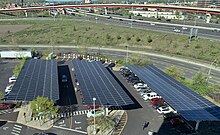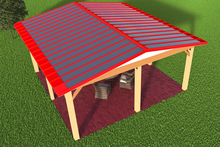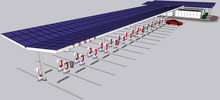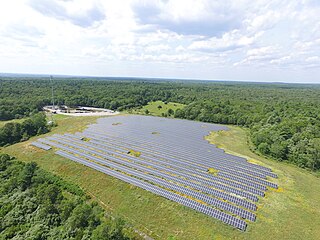


Solar canopies are solar arrays installed on canopies, which could be a parking lot canopy, carport, gazebo, Pergola, or patio cover.



Solar canopies are solar arrays installed on canopies, which could be a parking lot canopy, carport, gazebo, Pergola, or patio cover.

The mounting structure makes solar canopy parking lots 50% to twice as expensive to build as traditional grass field solar arrays, but as distributed energy resources they avoid transmission congestion and losses. [1] The canopies can protect the cars and asphalt from extreme weather.
A French law passed in 2023 will require parking lots larger than 50,000 square feet (4,600 m2) to build solar canopies covering half their area. This could result in installed capacity of 6.75–11.25 gigawatts, at a cost of $8.7–14.6 billion. [2]
In 2022, the world's largest solar car park canopy opened in the Netherlands with 35 MW capacity. [3]
Rutgers University is building 14.5 MW of solar canopies on parking lots in 2023, which will generate 18 GWh annually, in addition to the 32-acre 8.8 MW solar canopy parking lot already installed there in 2013. [4]
If Walmart Supercenters installed Solar canopies on their 3,500+ parking lots it would generate 11.1 gigawatts of solar power nameplate capacity. [5] [6]
Community Solar
Solar canopies have a lot of potential when developing community solar. Community solar can easily implement solar canopy development to provide nearby residents with a reliable source of renewable energy. This is beneficial for residents wanting to invest in solar that do not have the means to construct panels on their own property. [7] The use of solar canopies in community solar allows more people to have easy and reliable access to renewable resources without as many limitations, such as funds or space, as personal solar panels. [7] This is due to the fact that solar canopies are constructed over preexisting parking lots and other open areas within the community rather than within one's own property. Additionally, the construction of solar canopies within communities helps to provide covered parking areas for residents and can be used for shade in parks and other open spaces that house solar structures. [7]
At parks or backyard patios, gazebos can be installed as a solar canopy. [8] Some studies have looked into the development solar gazebos that rotate in order to follow sunlight as another option for solar energy. These solar panels operate on a Rotating Roof Gazebo System which allows the solar panels to turn towards the sun as it moves throughout the day. [9] This allows for the solar panels to have direct sunlight throughout most of the day unlike stationary solar panels that will only receive full sunlight for a limited period of time. Due to this, rotating solar gazebos can produce a higher percent of solar energy. [9]
These rotating gazebos can be beneficial to community solar as well. As stated in the Community Solar section, community solar provides renewable energy to many residents through solar structures built over parking lots and other open spaces. [7] Rotating gazebos can potential be implemented in a similar fashion to provide higher energy resources to community solar programs. [7] [9]

Some Tesla Supercharger stations have solar canopies installed to protect drivers and vehicles from the elements while recharging. Tesla Megapacks are also installed at some of these locations to store that energy locally. [10]


A canopy is an overhead roof or else a structure over which a fabric or metal covering is attached, able to provide shade or shelter from weather conditions such as sun, hail, snow and rain. A canopy can also be a tent, generally without a floor. The word comes from the ancient Greek κωνώπειον, from κώνωψ, which is a bahuvrihi compound meaning "mosquito". The first 'o' changing into 'a' may be due to influence from the place name Canopus, Egypt thought of as a place of luxuries.

Many countries and territories have installed significant solar power capacity into their electrical grids to supplement or provide an alternative to conventional energy sources. Solar power plants use one of two technologies:

Solar power is a major contributor to electricity supply in Australia. As of December 2023, Australia's over 3.69 million solar PV installations had a combined capacity of 34.2 GW photovoltaic (PV) solar power. In 2019, 59 solar PV projects with a combined capacity of 2,881 MW were either under construction, constructed or due to start construction having reached financial closure. Solar accounted for 12.4% of Australia's total electrical energy production in 2021.

Spain is one of the first countries to deploy large-scale solar photovoltaics, and is the world leader in concentrated solar power (CSP) production.
For solar power, South Asia has the ideal combination of both high solar insolation and a high density of potential customers.

Solar power has a small but growing role in electricity production in the United Kingdom.

Solar power has been growing rapidly in the U.S. state of California because of high insolation, community support, declining solar costs, and a renewable portfolio standard which requires that 60% of California's electricity come from renewable resources by 2030, with 100% by 2045. Much of this is expected to come from solar power via photovoltaic facilities or concentrated solar power facilities.

Turkey’s sunny climate possesses a high solar energy potential, specifically in the South Eastern Anatolia and Mediterranean regions. Solar power is a growing part of renewable energy in the country, with 12 gigawatts (GW) of solar panels generating 6% of the country's electricity. Solar thermal is also important.

Solar power in Pakistan became part of the energy mix in 2013, following government policies aimed at supporting renewable energy development. Benefiting from nine and a half hours of sunlight daily, the country now has seven solar projects that contribute 530 MW to the national grid. Rising electricity costs and grid reliability concerns have driven industries, businesses, and urban homeowners to increasingly turn to solar solutions, including rooftop photovoltaic installations.

A community solar project, farm or garden is a solar power installation that accepts capital from and provides output credit and tax benefits to multiple customers, including individuals, businesses, nonprofits, and other investors. Participants typically invest in or subscribe to a certain kW capacity or kWh generation of remote electrical production. The project's power output is credited to investors or subscribers in proportion to their investment, with adjustments to reflect ongoing changes in capacity, technology, costs and electricity rates. Community solar provides direct access to the renewable energy to customers who cannot install it themselves. Companies, cooperatives, governments or non-profits operate the systems.

Photovoltaic mounting systems are used to fix solar panels on surfaces like roofs, building facades, or the ground. These mounting systems generally enable retrofitting of solar panels on roofs or as part of the structure of the building. As the relative costs of solar photovoltaic (PV) modules has dropped, the costs of the racks have become more important and for small PV systems can be the most expensive material cost. This has caused an interest in small users deploying a DIY approach. Due to these trends, there has been an explosion of new racking trends. These include non-optimal orientations and tilt angles, new types of roof-mounts, ground mounts, canopies, building integrated, shading, vertical mounted and fencing systems.
Solar power in France including overseas territories reached an installed capacity figure of 11.2 GW in 2020, and rose further to 17.1 GW at the end of 2022. Government plans announced in 2022 foresee solar PV capacity in France rising to 100 GW by 2050.

Solar power in Ohio has been increasing, as the cost of photovoltaics has decreased. Ohio installed 10 MW of solar in 2015. Ohio adopted a net metering rule which allows any customer generating up to 25 kW to use net metering, with the kilowatt hour surplus rolled over each month, and paid by the utility once a year at the generation rate upon request. For hospitals there is no limit on size, but two meters are required, one for generation, the other for utility supplied power.

Solar power in West Virginia on rooftops can provide 23% of all electricity used in West Virginia from 6,300 MW of solar panels, but West Virginia will be the last state in the United States to reach grid parity - the point where solar panels are cheaper than grid electricity - without incentives, due to the low cost of electricity - about $0.062/kWh. The point where grid parity is reached is a product of the average insolation and the average cost of electricity. At $0.062/kWh and 4.3 sun-hours/day, solar panels would need to come down to ~$1,850/kW installed to achieve grid parity. The first state in the US to achieve grid parity was Hawaii. Solar power's favorable carbon footprint compared to fossil fuels is a major motivation for expanding renewable energy in the state, especially when compared to coal to generate electrical power.

Solar power in Saudi Arabia has become more important to the country as oil prices have risen. In 2021, 60.89% of energy consumed was produced by burning oil. The Saudi agency in charge of developing the nations renewable energy sector, Ka-care, announced in May 2012 that the nation would install 41 gigawatts (GW) of solar capacity by 2032. It was projected to be composed of 25 GW of solar thermal, and 16 GW of photovoltaics. At the time of this announcement, Saudi Arabia had only 0.003 gigawatts of installed solar energy capacity. A total of 54 GW was expected by 2032, and 24 GW was expected in 2020, which was never reached. 1,100 megawatts (MW) of photovoltaics and 900 megawatts of concentrated solar thermal (CSP) was expected to be completed by early 2013. Also in 2013, solar power in Saudi Arabia had achieved grid parity and was able to produce electricity at costs comparable to conventional sources.

Solar power in New Zealand is increasing in capacity, despite no government subsidies or interventions being available. As of the end of February 2024, New Zealand has 400 MW of grid-connected photovoltaic (PV) solar power installed, of which 130 MW (33%) was installed in the last 12 months. In the 12 months to December 2023, 372 gigawatt-hours of electricity was estimated to have been generated by grid-connected solar, 0.85% of all electricity generated in the country.

Tesla Supercharger is an electric vehicle DC fast-charging network built by American vehicle manufacturer Tesla, Incorporated.

Tesla Energy Operations, Inc. is the clean energy division of Tesla, Inc. that develops, manufactures, sells and installs photovoltaic solar energy generation systems, battery energy storage products and other related products and services to residential, commercial and industrial customers.

The Tesla Megapack is a large-scale rechargeable lithium-ion battery stationary energy storage product, intended for use at battery storage power stations, manufactured by Tesla Energy, the energy subsidiary of Tesla, Inc.

A solar landfill, also referred to as a brightfield, is a former landfill site that has been transformed into a solar array or solar farm. Landfills that are no longer in use are often called brownfields due to potential environmental concerns. By repurposing these brownfields into solar fields, they become known as brightfields. In the United States, there are more than 10,000 closed or inactive landfills, which have the potential to accommodate over 60 gigawatts of solar installations.